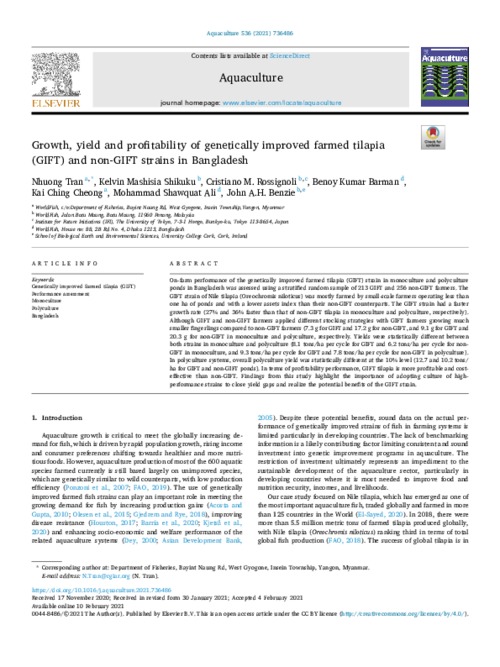Growth, yield and profitability of genetically improved farmed tilapia (GIFT) and non-GIFT strains in Bangladesh

On-farm performance of the genetically improved farmed tilapia (GIFT) strain in monoculture and polyculture ponds in Bangladesh was assessed using a stratified random sample of 213 GIFT and 256 non-GIFT farmers. The GIFT strain of Nile tilapia (Oreochromis niloticus) was mostly farmed by small-scale farmers operating less than one ha of ponds and with lower assets than their non-GIFT counterparts. The GIFT strain had a faster growth rate (27% and 36% faster than that of non-GIFT tilapia in monoculture and polyculture, respectively). Although GIFT and non-GIFT farmers applied different stocking strategies with GIFT farmers growing much smaller fingerlings compared to non-GIFT farmers (7.3 g for GIFT and 17.2 g for non-GIFT, and 9.1 g for GIFT and 20.3 g for non-GIFT in monoculture and polyculture, respectively,yields were statistically different between both strains in monoculture and polyculture (8.1 tons/ha per cycle for GIFT and 6.2 tons/ha per cycle for non-GIFT in monoculture, and 9.3 tons/ha per cycle for GIFT and 7.8 tons/ha per cycle for non-GIFT in polyculture). In polyculture systems, overall polyculture yield was statistically different at the 10% level (12.7 and 10.2 tons/ha for GIFT and non-GIFT ponds). In terms of profitability performance, GIFT tilapia is more profitable and cost-effective than non-GIFT. Findings from this study highlight the importance of adopting culture of high-performance strains to close yield gaps and realize the potential benefits of the GIFT strain.